Click to enlarge
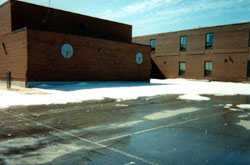 |
In the mid-1980s, a crusade to improve the quality of school grounds was initiated in Britain under the Learning through Landscapes programme. Word of its remarkable success soon spread across the Channel to Europe, and rapidly fanned out across the world to grow into an international movement. |
Click to enlarge
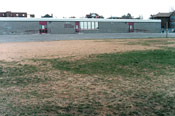 |
It was one of those old ideas whose time for renewal had come, and perhaps it has come just in time. Many people are now well-aware of the need to protect biodiversity and conserve dwindling natural resources. What has been less obvious is how to rescue ourselves in a hurry when the wheels of change turn so slowly. Enter the simple idea of starting with the ground at our children's feet.
Click to enlarge
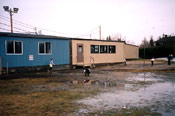 |
During the past decade, thousands of North American schools have begun to take a good, hard look at their grounds and realize the enormous potential for transforming barren expanses of asphalt and worn-out grass into exciting natural spaces for learning, playing and socializing. Bringing back to life the patch of the planet under us is an extremely hopeful act, particularly when it contributes to and strengthens a global regreening movement. The ripple-effect potential of greening up people and communities by greening up school grounds suddenly makes turning things around seem possible. Even probable.
[Back to top]
Since the 1850s, there have been several campaigns to transform North American school grounds. Some have focused simply on beautification or providing protection from "the fierce heat of Summer and the storms of Winter", while others have promoted student health and the development of the "symmetrical education of the individual".
Over the years, the school garden became an outdoor classroom providing spaces to teach math, banking, business practices, mechanical drawing, entomology, chemistry, botany and physical geography. These gardens were believed to cultivate civic virtues: "the private care of public property, economy, honesty, application, concentration, self-discipline, civic pride, justice, the dignity of labour, and the love of nature". In other words, school gardens helped children to become good, responsible citizens who would contribute to society.
By 1915, children's school gardening was recognized by leading educators as a very important factor in the health and whole education of the child, and in making cities more beautiful and more livable. During the 1940s, school Victory Gardens enabled young people to make a contribution to the war effort. However, by the end of that decade, school gardening declined and gardens were replaced with formal plantings of grass and trees, perhaps reflecting a desire for peace and an end to strife.
Today, we have a compelling new goal for an old practice, that of educating about the need to restore the Earth to health, and of reconnecting with, and learning to work in cooperation with, the natural world.
[Back to top]
Outdoor classrooms can embrace virtually anything: habitat restoration and naturalization projects; butterfly meadows, ponds, insect gardens, and hedges with shrubs that provide food and shelter for small mammals and birds; artistic creations such as sculpture gardens, giant chess boards, wall murals and pavement paintings; nurseries for native plants; and vegetable, herb, berry, perennials and rock gardens. Bats and birds can be attracted by installing roosting boxes, nesting boxes and feeders. In Britain, keeping animals such as sheep, goats, chickens, ducks, rabbits and pigs is gaining in popularity, and some schools even have bee-keeping clubs.
Click to enlarge
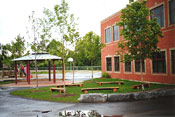 |
Amphitheatres formed of simple naturalized berms can provide outdoor classroom space for music, dance and theatre. A space for the performing arts can be easily made by setting several upright posts in the ground with fixtures to attach canvas backdrops and props. The scope of school grounds transformation is limited only by the reach of the imagination. The more diverse the approach, the greater the potential for integrating all areas of the curriculum.
The choices made by each school will be determined largely by site-specific drawbacks and advantages. A suburban or rural school may have many acres of land available for nature gardens while an inner city school may be restricted to rooftop vegetable and flower gardening. No matter how limited the space for greening, it is always possible to maximize its potential by, for example, installing container gardens in corners, growing climbing plants along dull stretches of chain-link fencing, and hanging bird feeders and flower baskets from wall brackets.
Outdoor classrooms offer a wide range of on-site experiential situations including sensing, handling, manipulating, creating, thinking, analyzing, feeling excitement, recording, reporting, observing, investigating, comparing, assessing, being involved, communicating, calculating, measuring, counting, predicting, making choices, judgements and decisions, and working independently and cooperatively.
[Back to top]
But what are the benefits? Is this going to mean an additional workload for teachers? What about the cost, and the health and safety factors?
Click to enlarge
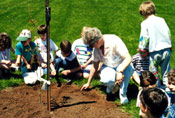
Photo: Karen Spinney-Helmer |
The economic benefits are less immediately obvious but become apparent over time. For example, rather than going to the landfill, organic waste can be composted and used to restore nutrient-depleted soils; learning about natural cycles can persuade students to abandon non-biodegradable packaging in favour of refillable containers, which helps to decrease waste and tipping charges; low-maintenance gardens and ground covers can replace energy-intensive, high-maintenance lawns that need mowing and watering regularly and fertilizing, re-seeding and aerating annually; and fostering a sense of ownership can reduce wilful damage to school property. As for costs, many materials and in-kind services can be supplied through community donations and participation.
Not to be forgotten either are the less-quantifiable, long-term benefits associated with physical activity out of doors. Planting shade trees reduces children's risk of exposure to harmful ultraviolet radiation, and trees also help to filter dust and pollutants from vehicle exhaust.
[Back to top]
Reconnecting with nature
Click to enlarge
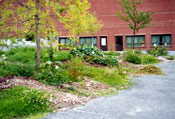 |
School grounds projects designed to bring nature back into our daily lives are crucial for the long term conservation, protection and restoration of wild places and wildlife. Most young people never have the opportunity to experience wilderness and many living in urban settings have very limited opportunities to explore natural environments. As visits to outdoor education centres become limited by financial constraints, the danger exists that learning about the natural world will increasingly depend upon printed and electronic materials. Teaching in this way is largely an academic abstraction; it cannot foster the kind of lifelong ecological consciousness that can be derived only from learning through the senses in natural settings throughout childhood. Nature, as it has often been repeated, is our best teacher.
If your school grounds are nothing but barren rectangles of hard surfaces and pounded grass, perhaps it is time to take a closer look at the options for changing your children's living and learning environments and for depaving the way to a better and more hopeful future. There can be no better place than our schools for beginning humanity's greatest task - that of reconnecting ourselves to the natural world.
[Back to top]